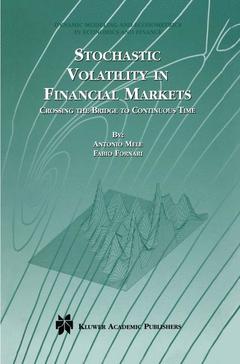Description
Stochastic Volatility in Financial Markets, Softcover reprint of the original 1st ed. 2000
Crossing the Bridge to Continuous Time
Dynamic Modeling and Econometrics in Economics and Finance Series, Vol. 3
Authors: Mele Antonio, Fornari Fabio
Language: English
Subjects for Stochastic Volatility in Financial Markets:
Keywords
Finance; asset pricing; econometrics; financial markets; option pricing; volatility
Stochastic Volatility in Financial Markets
Publication date: 10-2012
147 p. · 15.5x23.5 cm · Paperback
Publication date: 10-2012
147 p. · 15.5x23.5 cm · Paperback
105.49 €
Subject to availability at the publisher.
Add to cart
Stochastic volatility in financial markets
Publication date: 05-2000
147 p. · 15.5x23.5 cm · Hardback
Publication date: 05-2000
147 p. · 15.5x23.5 cm · Hardback
Description
/li>Contents
/li>
Stochastic Volatility in Financial Markets presents advanced topics in financial econometrics and theoretical finance, and is divided into three main parts. The first part aims at documenting an empirical regularity of financial price changes: the occurrence of sudden and persistent changes of financial markets volatility. This phenomenon, technically termed `stochastic volatility', or `conditional heteroskedasticity', has been well known for at least 20 years; in this part, further, useful theoretical properties of conditionally heteroskedastic models are uncovered. The second part goes beyond the statistical aspects of stochastic volatility models: it constructs and uses new fully articulated, theoretically-sounded financial asset pricing models that allow for the presence of conditional heteroskedasticity. The third part shows how the inclusion of the statistical aspects of stochastic volatility in a rigorous economic scheme can be faced from an empirical standpoint.
1 — Introduction.- 1.1 Background and aims of the monograph.- 1.2 Empirical models in discrete time.- 1.3 Theoretical issues.- 1.4 Statistical inference.- 1.5 Plan.- 2 — Continuous time behavior of non linear ARCH models.- 2.1 Introduction.- 2.2 Approximation results for a general class of non linear ARCH models.- 2.3 Interpretation of the moment conditions.- 2.4 Effectiveness of ARCH as diffusion approximations of theoretical models.- 2.5 Limiting behavior of the error process.- 2.6 Continuous time behavior of the volatility switching models.- Appendix A: proofs on convergence issues.- Appendix B: proofs on distributional issues.- Appendix C.- 3 — Continuous time stochastic volatility option pricing: foundational issues.- 3.1 Introduction.- 3.2 The reference model.- 3.3 Applications to stochastic volatility.- 3.4 On mean self-financing strategies and the minimal martingale measure.- Appendix: relative entropy and the minimal martingale measure.- 4 — Models of the term structure with stochastic volatility.- 4.1 Introduction.- 4.2 From the one factor model to the modelling of conditional heteroskedasticity.- 4.3 Searching for affinity.- 4.4 Early equilibrium-based models.- 4.5 A class of equilibrium models of the term structure with stochastic volatility.- 4.6 Concluding remarks: taking account of nonlinearities.- 5 — Formulating, solving and estimating models of the term structure using ARCH models as diffusion approximations.- 5.1 Introduction.- 5.2 Specification of the theoretical models.- 5.3 Econometric strategy.- 5.4 The pure numerical solution of the theoretical models.- 5.5 An illustrative example.- Appendix: a solution method based on the approach of iterated approximations.- References.
© 2024 LAVOISIER S.A.S.
These books may interest you

Time Series Econometrics 89.66 €



